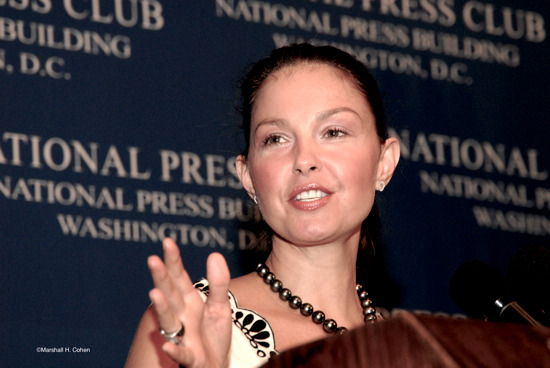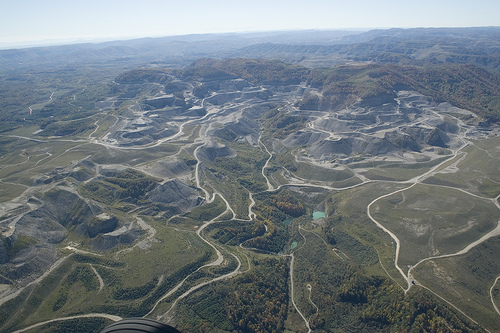 Ashley Judd speaking about mountaintop removal at the National Press Club.
Ashley Judd speaking about mountaintop removal at the National Press Club.
Cross-posted from onearth.
I love and am proud of being a hillbilly. I trace my family in the mountains of eastern Kentucky back at least eight generations. There is no better home than Kentucky. But the land I love and the way of life there that I so cherish are endangered.
There is a searing tear, a gaping wound in the fabric of my life and in the lives of all Appalachians. And it gets bigger every day with every Appalachian mountaintop that is blown up, every holler that is filled, every stream that is buried, every wild thing that is wantonly and recklessly killed, every ecosystem that is diminished, every job that is lost to mechanization, every family that is pitted one against the other by the state-sanctioned, federal government supported coal industry operated rape of Appalachia. I’m talking about mountaintop removal coal mining.
The Appalachian Mountains are the oldest in North America; they may well be the oldest mountains in the entire world. Peaks and ridges so ancient that geologists call them — rather poetically, I think — “deep time.” Mountaintop removal only happens here; on no other mountain range in the United States would it be allowed to happen. Indeed, it is utterly inconceivable that the Smokies would be blasted, the Rockies razed, the Sierra Nevadas flattened — that bombs the equivalent to Hiroshima would be detonated every single week for the past three decades. The fact that the Appalachians are the Appalachians makes this environmental genocide possible and permissible.
The federal Surface Mining Control and Reclamation Act (SMCRA), which passed in 1977 during the Carter administration, was inadequate from the start. Coal mining techniques out-distanced regulation immediately, not to mention the appalling lack of oversight and enforcement. As shocking as strip mining was then, mountaintop removal is warp speed over-drive — strip mining on steroids, as it’s known.
 Appalachian mountaintop removal.Photo: Kent Kessinger for iLoveMountains.orgHere’s how it works: After permits are approved — all too easily in most cases — by state and federal agencies, access roads are carved up to the mountaintop. The lush forests, among the most biodiverse habitats in the entire world, are cut down. They are not even harvested; the old growth trees are simply razed and the land graded level. Next, explosives are trucked in — explosives so volatile they must be transported on separate vehicles — and tucked inside small holes that are drilled into the table-top flat rocky surface. Every single day, around the clock, seven days a week, 2,500 tons of explosives are detonated — blasts 100 times greater than the bomb that brought down the Oklahoma City Federal Building. What once was an ecologically and potentially economically rich resource is reduced to piles of loose rubble, dirt, and debris — “overburden” in mining industry parlance.
Appalachian mountaintop removal.Photo: Kent Kessinger for iLoveMountains.orgHere’s how it works: After permits are approved — all too easily in most cases — by state and federal agencies, access roads are carved up to the mountaintop. The lush forests, among the most biodiverse habitats in the entire world, are cut down. They are not even harvested; the old growth trees are simply razed and the land graded level. Next, explosives are trucked in — explosives so volatile they must be transported on separate vehicles — and tucked inside small holes that are drilled into the table-top flat rocky surface. Every single day, around the clock, seven days a week, 2,500 tons of explosives are detonated — blasts 100 times greater than the bomb that brought down the Oklahoma City Federal Building. What once was an ecologically and potentially economically rich resource is reduced to piles of loose rubble, dirt, and debris — “overburden” in mining industry parlance.
Using shovels the size of buildings, the essential ingredients of deep time are pushed into the lauded and mythical hollers of Appalachia, indiscriminately burying perennial and permanent valley streams, along with all plants, wildlife, and aquatic species, and poisoning the drinking water with a witch’s brew of toxic metals.
This is the reason that children in eastern Kentucky draw creeks black.
They don’t know that water is supposed to run clear.
To get the coal out, drag lines 20 stories high scoop out the narrow seams that lie like layers of a chocolate cake. In many cases, once the coal company is finished, the mine site is simply abandoned. The coal company often sets up a shell corporation or two to operate a job, and then defaults on the bond. In other cases, the company decides to make the site a model example of their “responsibility” by reshaping the lowered mountain to its “approximate original contour.” Of course, the word “approximate” makes it a farce. That word was a government concession to powerful coal interests. Then non-native plants and fast-growing, invasive grasses are planted. With inexhaustible gall and incessant propaganda, the companies celebrate the “restored” or “reclaimed” site as an example of how good for Appalachia mountaintop removal coal mining is.
Why, they even built a prison on one former site and guess what? The foundation subsided and the locals call it “Sink Sink.” On another site they built a golf course. I’m not too keen on reinforcing stereotypes about my people, but I don’t know a lot of hillbillies who golf.
According to a study by the Natural Resources Defense Council, the coal companies have reclaimed only a fraction of the mountains they’ve leveled for the economic benefit of surrounding communities. What’s really happening after mountaintop removal is “wrecklamation.”
And no one should be fooled into thinking that the price paid in leveled landscapes and polluted communities after mining is done is worth the cost because of jobs. All those giant machines and explosives used to literally remove the mountain from the coal don’t require nearly as many workers as traditional underground mining. There are only a few thousand surface miners working in Appalachia today — nowhere near the peak of 150,000 plus who pulled coal out of the ground several decades ago. But there’s more coal coming out of Appalachia than ever before.
You see, mountaintop removal also removes the miners from mining.
It’s important that those of us fighting the coal companies stick together because they can make me feel absolutely and totally crazy.
Their denial, smoke-and-mirrors, sleight of hand, and relentless propaganda are absolutely stunning. But I know what is happening to my homeland. I know how outrageous it is. Yet, they try to make us feel like lunatics, out of touch with reality, and like fringe conspiracy theorists. After all, no one would really let this happen to America’s oldest mountains, right? Certainly our government would stop it.
Sadly, inexplicably, the tragedy of mountaintop removal is real. But by our own relentless spirit and unshakable faith in justice, we are making a difference. We must keep up the pressure. We must support the grassroots groups and national organizations that are fighting in the trenches every day to save Appalachia. And we need your help. Visit NoMoreMountaintopRemoval.org to join this noble cause.



